"Your sail was of fine
embroidered linen from Egypt Sidon
and Arvad were your rowers ; Your wise men, O Tyre

From June 13, 2012, to June 28, 2012 the Sun will in the Argo Navis Constellation ...
The Upper Zodiac mystery ... The Tenth Sign – “ SHIP
(HELMSMAN) “ … Recollect the Odyssey, the Argonauts - that it was easier to understand the
characteristic of this Sign…
Last sign on the Upper Zodiac… It is border of the Gemini and the Cancer …
this is spiritual - the transformation time ... This is more of a spiritual
transformation of human life ... it's not physical life time ... This is the exam time - moving from Gemini into Cancer Zodiac .. This is the constellation of Argo
Navis mystery...
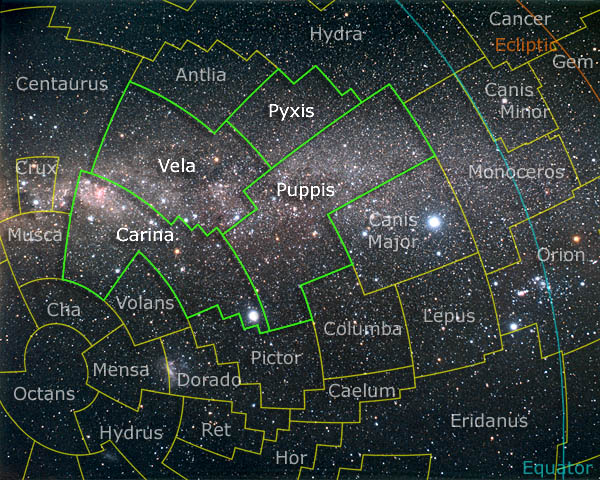
Now at us the Argo Navis
dismembered. Here enter the whole 4 constellations - the Puppis, Vela,
Carina and the Pyxis, and there was one big constellation of the Helmsman or
the Ship earlier. In the sky the Chariot, and goes Argo Navis (the Ship)
further...
The Sea Ship - is a mission, overcoming of weight of dangers, illusions and
fears, struggle against own generations and chimeras, flying Dutches, a victory
over illusions. This sensation of any invisible and far purpose…



 Read here: "Retrograde
Read here: "Retrograde Neptune
- Heaven Exam time" 

 Read here: "The Twelve Apostles (Dvylika apaštalų)"
Read here: "The Twelve Apostles (Dvylika apaštalų)"

This is Heaven Exam time
... Exam questions - "Ten Commandments of God"...

Lord of the Sea - NEPTUNE -
also prepare for the Exam ... He turned back (Retrograde)...

"But evil will come on you Which you will not know
how to charm away ; And disaster will fall on you For which you cannot atone ;
And destruction about which you do not know Will come on you suddenly.Stand
fast now in your spells And in your many sorceries With which you have labored
from your youth ; Perhaps you will be able to profit, Perhaps you may cause
trembling.." Isaiah 47:11-12, Biblija
 Read here: "Retrograde
Read here: "Retrograde 
Life of humans who walked abreast with the Son of God - Heaven messenger..

Faith without works is dead... "But now Faith,
Hope, Love, abide these three ; but the greatest of these is Love." 1 Corinthians 13:13, Bible
 Read here: "The Twelve Apostles (Dvylika apaštalų)"
Read here: "The Twelve Apostles (Dvylika apaštalų)" 


June 13, 2012... Sun 22.5 degrees Gemini....
June 28, 2012... Sun 7.5 degrees Cancer…
The Tenth
Sign - between Gemini and the Cancer - the HELMSMAN, the SHIP.

The Chariot overland,- and the Ship
sea. The Sea Ship - is a mission, overcoming of weight of dangers, illusions
and fears, struggle against own generations and chimeras, flying Dutches, a
victory over illusions. This sensation of any invisible and far purpose…
Recollect the Odyssey, the
Argonauts …
The Argonauts - were a band of
heroes in Greek mythology who, in the years before the Trojan War, accompanied
Jason to Colchis (ancient Georgian
Kingdom
The Odyssey - is one of two major
ancient Greek epic poems attributed to Homer. It is, in part, a sequel to the
Iliad, the other work ascribed to Homer. The poem is fundamental to the modern
Western canon, and is the second—the Iliad being the first—extant work of
Western literature. It is believed to have been composed near the end of the
8th century BC, somewhere in Ionia, the Greek coastal region of Anatolia … There is a strong theme of homecoming (nostos)
in the Odyssey, because Odysseus is on a journey home after the Trojan war has
finally ended…
Byron - the Ship.. . Eternal trips,
travel, romantic adventures. Also has died far from the house…

Lord Byron (22 January 1788 – 19
April 1824) - was a British poet and a
leading figure in the Romantic movement. Among Byron's best-known works are the
brief poems She Walks in Beauty, When We Two Parted, and So, we'll go no more a
roving, in addition to the narrative poems Childe Harold's Pilgrimage and Don
Juan. He is regarded as one of the greatest British poets and remains widely
read and influential…

He enjoyed adventure, especially
relating to the sea.The first recorded notable example of open water swimming
took place on 3 May 1810 when Lord Byron swam from Europe to Asia across the Hellespont Strait

Byron exercised a marked influence
on Continental literature and art, and his reputation as a poet is higher in
many European countries than in Britain or America, although not as high as in
his time, when he was widely thought to be the greatest poet in the world.. Byron has inspired works by Franz Liszt, Hector Berlioz, Pyotr Ilyich
Tchaikovsky, and Giuseppe Verdi…

During his lifetime, in addition to
numerous dogs and horses, Byron kept a fox, four monkeys, a parrot, five cats,
an eagle, a crow, a crocodile, a falcon, five peacocks, two guinea hens, an
Egyptian crane, a badger, three geese, a heron and a goat with a broken leg.
Except for the horses, they all resided indoors at his homes in England , Switzerland ,
Italy and Greece

After his return from his travels,
he again entrusted Dallas



 Read here: MARKED Human of Heaven (Upper Zodiac)
Read here: MARKED Human of Heaven (Upper Zodiac)


Argo Navis
constellation
Argo Navis is a giant mythical sailing vessel
afloat on the southern Milky Way. Much of this unweildy constellation is
nowadays unseen from mid-northern latitudes, but because of astronomical
precession more of it was visible in ancient times. The construction of this
ship of the sky seems to have been an ancient Greek idea, and the constellation
is listed as one of Ptolemy's original 48, but the only one that was not
incorporated as a whole into the International Astronomical Union's 1930's
formalisation of the constellation boundaries... This large constellation was
one of the 48 constellations described by the ancient astronomer Ptolemy in his
Almagest. It is the ship which Argus built for Jason and his crew, the
Argonauts, to carry them on their quest for the Golden Fleece. In the 18th
century the French astronomer Lacaille divded it into three smaller
constellations, Carina the Keel, Puppis the Stern or Poop, and Vela the Sail...
One legend has it that the mythical ship was created for Jason, who sailed
with the Argonauts in search of the Golden Fleece. The vessel was later
refitted as an Ark to suit other beliefs, but in the 1760s it was broken up by
the French cleric and astronomer Nicolas de Lacaille into the four sections we
recognise today, Carina, the keel, Puppis the stern, Vela the sails and Pyxis,
the mariner's compass...
This part of the sky is best seen in the early evening between April and
August...
Constellation of Carina
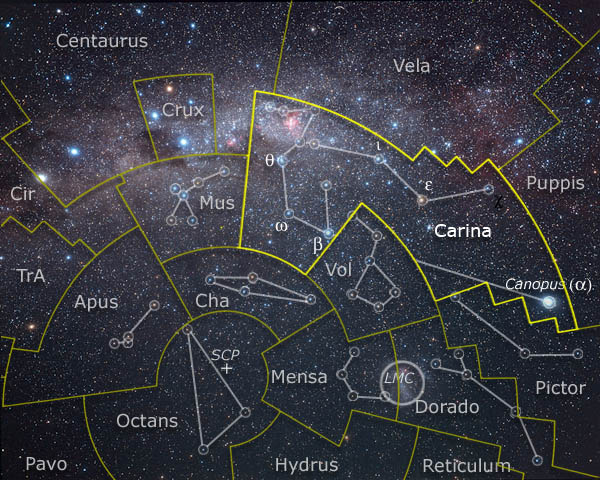
Carina the Keel, is a remnant of Argo Navis, a giant mythical sailing
vessel afloat on the southern Milky Way, described elsewhere. The constellation
is a delight for southern hemisphere observers, with many star clusters and
nebulae visible in binoculars or modest telescopes. Some of these are quite
spectacular in a large telescope (see below)...

Carina is the Keel of the ship Argo Navis. The keel of a ship is a large
single beam, the very bottom of the ship's hull, the foundation beam that
supports the entire ship; the ship's backbone. The laying of the keel is the
first event in a ship's construction and is a symbolic act marked by a formal
ceremony involving dignitaries...
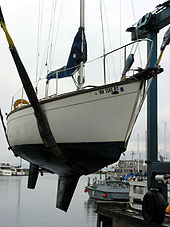
"Lay the keel" is a term used for
beginning of a important undertaking. The ritual of laying a foundation stone
for a building is analogous to laying of the ship's keel, and that event is
also often marked with a ceremony...
Constellations of Puppis
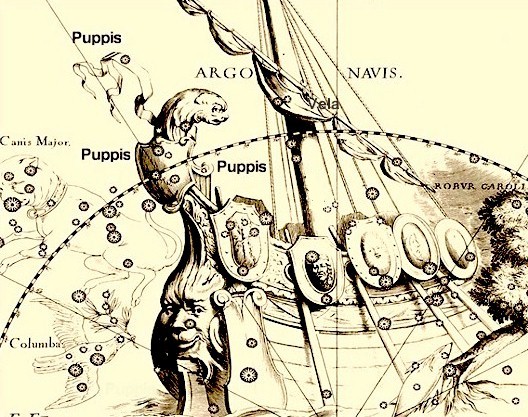
Puppis the Stern of the Ship Argo Navis ... Puppis (the Stern) is the
largest of the four constellations that were constructed out of the great
vessel Argo Navis. The original division was made by Nicolas Louis de Lacaille
in the 1750s, but it was formalised by the International Astronomical Union in
the 1930s...

Puppets carry a mystic meaning relevant to this celestial feature; that we
may be controlled by the stars like puppets on a string. Penguin Dictionary of
Symbols explains what was believed about puppets:
"The Mahabharata has the words: 'Human behavior is controlled from the
outside like that of a wooden doll on the end of a string.' And in the
Upanishads there is: 'Do you know the thread by which is attached this world
and the other and all the beings in them, and the hidden Master who controls
them from within?' When the craving for the One is satisfied, the human will be
absorbed in Plato's golden thread which governs us, puppets that we are. Plato
said that, by virtue of all that is best in it, mankind is the plaything of
God, while Jacob Boehme wrote: 'You will achieve nothing until you abdicate
your own will, that is, what you call 'I' or 'myself'.' Ananda Coomaraswamy
conjures up the ecstatic rapture of the puppet 'acting without action' in the
sense taught by the Bhagavad Gita and the Taoist doctrine of wi wu wi. Freedom
is not to be gained by uncoordinated movement, but by becoming aware that in
joining in 'the dance of phenomena' we may identify with the puppet-master who
controls us."...
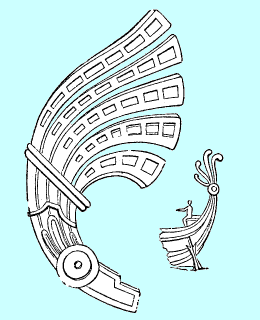
"... triumphantly directing to the stars his (man's) star-like eyes,
looks ever more closely at Olympus and inquires into the nature of Jove (God)
himself; .... and in his quest of a
being akin to his own, seeks himself among the stars. ... thus the tiny pupil
of the eye takes in the whole of the heaven and their eyes owes their vision to
that which is very small whilst what they behold is very large"...
Constellations of Vela
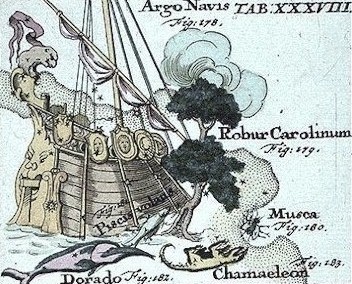
Vela the Sails of the Ship Argo Navis ... Vela (the sails) is best known
for the supernova remnant seen on large telescope pictures (below) and the Gum
nebula, visible as faint red nebulosity towards the right (west) of the
constellation...

Isis is the chief Egyptian goddess. The ancient writer Proclus speaks of a
statue which carried her name and the inscription which translates: 'I am that
which is, has been, and shall be. My veil no-one has lifted. The fruit I bore
was the sun'. This gives rise to the saying: 'To lift the veil of Isis', i.e.
to uncover a great secret...

"Apocalypsis is translated from Greek into Latin as 'revelation'
(revelatio), and a revelation means a manifestation of things that were hidden,
as John himself says (Apoc. 1:1): "The Revelation (Apocalypsis) of Jesus
Christ, which God gave unto him, to make known to his servants"...
Constellations of Pyxis
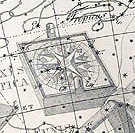
Pyxis Nautica the Mariner's Compass ... Pyxis, the Mariner's Compass was
originally Pyxis Nauticus and referrs to the magnetic compass. It is a small,
insignificant arrangement of faint stars surrounded by much more eyecatching
patterns of stars... Pyxis was once part of the very large constellation Argo
Navis, the ship Argo, which carried Jason and the Argonauts. Argo Navis is now
obsolete, but it was listed in Ptolemy's star catalogue, the Almagest... Best seen in the early evening
in March-April..
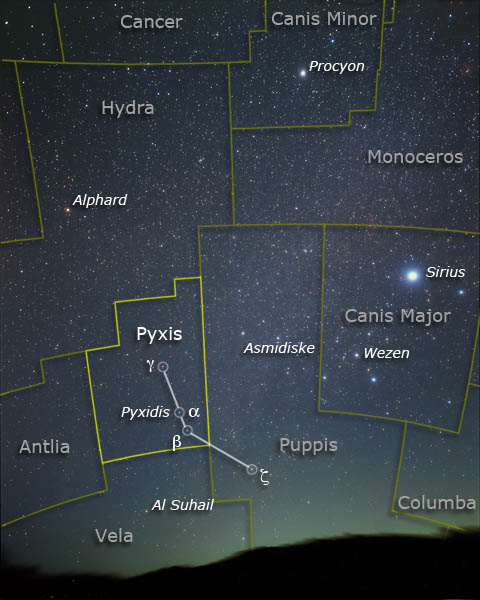
Pyxis is composed of stars that formed the constellation of Malus, the
ship's mast. The constellation, Pyxis, is in the position where the mast of the
Ship, Argo Navis, should be. The mast of a sailing ship is a tall vertical pole
which supports the sails (Vela)...
Isidore says “The mast is the pole on a ship that holds up the sail. It is
called a mast (malus) because it has the shape of an apple (malum) at the top
...”

Latin malum, means apple. 'Adam's Apple' is the 'voice box' or larynx from
Greek larunx, the box containing the vocal cords. The larnax (plural larnakes)
may be a related word, it is a type of closed box or coffin often used as a
container for human remains in ancient Greece, or ashes of the cremated ...
Folklore has it that the 'forbidden fruit' offered by Eve got stuck in Adam's
throat, hence the prominent voice box in men...

Pyxis used to be called Malus, the Mast. Allen in Star Names says: "La
Caille formed from stars in the early subordinate division Malus, the Mast,
Pyxis Nautica, the Nautical Box or Mariner's Compass, the German See Compass,
the French Boussole or Compas de Mer, and the Italian Bussola; and this is
still recognized by some good astronomers as Pyxis"...
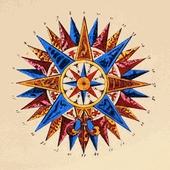
Argo Navis mythology
Low on the southern horizon lies the crown jewel of spring equatorial
skies. There are now six constellations among these stars. They are Puppis the
Poop, Vela the Sails, Pyxis the Compass, Carina the Keel, Volans the Flying
Fish and Columba the Dove. These six constellations are the dismembered parts
of a much larger constellation outlined by the ancient Greeks. They called it
the Great Ship Argo Navis...

There are two animals associated with the Great Ship Argo Navis. One is
Columba the Dove, forever leading the way westward for the ship. Columba can be
viewed as either sitting on the stern of the ship or flying before it. Columba
is easy to find, it lies just below Lepus the Hare, who in turn is lying at the
feet of Orion the Hunter...
Argo Navis represents the 50-oared galley in which Jason and the Argonauts
sailed to fetch the golden fleece from Colchis in the Black Sea. Jason
entrusted the building of the ship to Argus, after whom it was named. Argus
built the ship under the orders of the goddess Athene at the port of Pagasae,
using timber from nearby Mount Pelion. Into the prow Athene fitted an oak beam
from the oracle of Zeus at Dodona in north-western Greece. This area, like the
island of Corfu nearby, was once noted for its forests of oak, before later
shipbuilders stripped them bare. Being part of an oracle, this oak beam could
speak and it was crying out for action by the time the Argo left harbour...

Argonauts to sail to fetch the Golden Fleece from Colchis (Iolcus) in the
Black Sea. The Argo was built by the shipwright Argos or Argus. It was built at
the port of Pagasae, using timber from nearby Mount Pelion...
Argo Navis dominates this crowded scene in the southern celestial
hemisphere in the Uranographia of Johann Bode (1801). On the blade of one of
the steering oars lies the bright star Canopus, now part of the constellation
Carina...
The prow of the ship was usually imagined as disappearing between the
Clashing Rocks or vanishing into the mists of the Milky Way, but here the rocks
are replaced by Charles’s Oak (Robur Caroli II), a now-obsolete constellation
invented by Edmond Halley. Unlike other depictions of Argo, this version has no
main mast rising from the body of the ship. The spar around which the sail is
wrapped appears to emerge from the stern, but this may be an artistic error...

Because of Argo’s considerable size, cartographers struggled to depict it
successfully on a single chart. The attempt by Bode above is perhaps the best,
but for some alternative views click here...
Apollonius of Rhodes, who wrote the epic story of the ship’s voyage to
Colchis and back, described Argo as the finest ship that ever braved the sea with
oars. Even in the roughest of seas the bolts of Argo held her planks together
safely, and she ran as sweetly when the crew were pulling at the oars as she
did before the wind. Isaac Newton thought the voyage of the Argo was
commemorated in the 12 signs of the zodiac, although the connections are hard
to see...
Among the greatest dangers the Argonauts faced en route were the Clashing
Rocks, or Symplegades, which guarded the entrance to the Black Sea like a pair
of sliding doors, crushing ships between them. As the Argonauts rowed along the
Bosporus, they could hear the terrifying clash of the Rocks and the thunder of
surf. The Argonauts released a dove and watched it fly ahead of them. The Rocks
converged on the dove, nipping off its tail feathers, but the bird got through.
Then, as the Rocks separated, the Argonauts rowed with all their might. A
well-timed push from the divine hand of Athene helped the ship through the
Rocks just as they slammed together again, shearing off the mascot from Argo’s
stern. Argo had become the first ship to run the gauntlet of the Rocks and
survive. Thereafter the Clashing Rocks remained rooted apart...

Once safely into the Black Sea, Jason and the Argonauts headed for Colchis.
There they stole the golden fleece from King Aeëtes, and made off with it back
to Greece by a roundabout route. After their return, Jason left the Argo
beached at Corinth, where he dedicated it to Poseidon, the sea god...

Eratosthenes said that the constellation represents the first ocean-going
ship ever built, and the Roman writer Manilius concurred. However, this
attribution must be wrong because the first ship was actually built by Danaus,
father of the 50 Danaids, again with the help of Athene, and he sailed it with
his daughters from Libya to Argos...
Argo was first subdivided into Carina, Puppis and Vela by the French
astronomer Nicolas Louis de Lacaille in his catalogue of the southern stars
published in 1756 and it now lies permanently dismembered. There is, though,
still an echo of its former unity. Lacaille was dissatisfied with Bayer’s
allocation of Greek letters to the stars of Argo, so he decided to change them.
However, when he did so, he used just one sequence of Greek letters, from Alpha
to Omega, as though Argo were still a single figure. The designations Alpha and
Beta were given to the two brightest stars of Argo, which are in Carina; hence
there are no stars labelled Alpha or Beta in either Puppis or Vela. Equally,
the brightest star in Puppis is Zeta and the brightest in Vela is Gamma, but
there is no Zeta or Gamma Carinae...

Argo Navis is a symbolic archetype of a great ship, which crosses the
waters of the Deluge as in the Biblical tale of Noah's Arc. It lies entirely in
the southern hemisphere, east of Sirius (Canis Major), south of the
Constellations of Monoceros and Hydra and is largely in the Milky Way...
In ancient Egypt it was seen as the boat which carried Isis and Osiris over
the deluge. And the Hindus said that it performed the same function for Isi and
Iswara, they called it the ship Argha, which is similar to the Greek title.
Others say that the word Argo comes from the Semitic word arek meaning 'long'.
The Babylonian Epic of Creation relates how the gods decided to destroy the
earth with a flood. The god Ea took pity on humanity and secretly warned a
mortal named Uto-Napishtim of the forthcoming disaster. The man set about
building a boat 120 cubits high to carry his family, possessions and sundry
animals and birds. After the flood subsided, Uto-Napishtim and his passengers were
the only survivors. Another Greek tradition according to Eratosthenes, asserted
that Argo Navis represented the first ship to sail the ocean which carried
Danoes and his fifty daughters from Egypt to Rhodes...
As bearers of the Sun and Moon ships represent fecundity and the fertility
of the waters; they also represent adventure, exploration, setting out on the
sea of life and thus the symbol of life "the journey of life", but
also crossing the waters of death; in this connection ships share the bridge symbolism
in crossing from this world to the next. The architectural form of the Church
was compared with a ship; the nave from Latin navis is the central part of a
church...

Ships conjure up ideas of strength and safety in dangers of a voyage and
the symbolism is as applicable to space-flights as to sea-travel. The ship is
like a star which orbits about its pole, the earth, but under human control. It
is a picture of life in which the individual must choose a goal and steer a
safe course through the waves of worldly dangers. There is another aspect which
shows the exaggerated, or perverted qualities of the ship symbolism; it is told
in the old Scandinavian legend of a ghost-ship, on which Wagner based his
Flying Dutchman, symbolizing the quest for fidelity in love and the shipwreck
of that ideal, exposed as nothing more than a phantom. The ghost-ship
symbolizes those dreams inspired by the highest ideals, but which are
impossibly idealistic and cannot be realized...
The Ship appears to have no bow, this loss of its bow is said to have
occurred when Argo passed "Through Bosphorus betwixt the jostling
rocks" - the Symplegades, yet it has often been, as in The Alfonsine
Tables, illustrated and described by artists and authors, as a complete double-masted
vessel with oars, and Lubienitzki, in the Theatrurn Comelicum of 1667, as a
three-masted argosy with a tier of ports and all sails set full to the wind...

The Arabians called it Al sariuah, a Ship, and Markab, something to ride
upon. The biblical school naturally called it, Noah's Ark, the Arca Noachi, or
Archa Noae as Bayer wrote it; Jacob Bryant, the English mythologist of the last
century, making its story another form of that of Noah. Indeed in the 17th
century the Ark seems to have been its popular title. The constellation is
noticeable in lower latitudes for its great extent and the splendour of
Canopus...
Christian legend identifies the constellation as Noah's Ark:
"The biblical school of course called it Noah’s Ark, the Arca Noachi,
or Archa Noae as Bayer wrote it; Jacob Bryant, the English mythologist of the
last century, making its story another form of that of Noah. Indeed in the 17th
century the Ark seems to have been its popular title"



Argo Navis
žvaigždynas

Nuo 2012 m. birželio 13 iki 2012 m. birželio 28 Saulė keliaus Argo Navis žvaigždynu...

Tai Viršutinio Zodiako misterija... Dešimtasis Ženklas – “Laivas
( Vairininkas)“... Tai yra siena tarp Dvynių ir Vėžio zodiako … tai dvasinis -
transformacijos laikas... Tai yra daugiau dvasinis žmogaus gyvenimo transformacijos laikas ... Tai
egzamino laikas - pereinant iš Dvynių
zodiako į Vėžio zodiaką … Tai Argo Navis žvaigždynas …Nicolas Louis de
Lacaille 1763 m. Argonautų Laivo žvaigždyną
padalino į Burių, Kompaso, Laivo Kilio ir Laivagalio žvaigždynus (Puppis, Vela, Carina ir Pyxis) ...

Jūros Laivas - yra misija, įveikimas pavojų, iliuzijų ir
nuogąstavimo, kova prieš savo iliuzijas,
baimes, chimeras, - tai pergalė prieš iliuzijas .. . Tai bet kokio nematomo ir tolimo tikslo sensacija
…

Atsiminkite Odisėją, Argonautus - kad būtų lengviau suprasti šio Ženklo savybes …

Lordas Baironas – “Laivas“, šio ženklo atstovas.... Amžinos
kelionės, kelionė jūromis, romantiški nuotykiai... Taip pat mirė jis toli nuo namų …



"Tavo burės pagamintos iš Egipto margos drobės; mėlynas ir raudonas
purpuras iš Elišos salų dengė tave.Sidono ir Arvado gyventojai buvo tavo
jūrininkai, o tavo išminčiai, Tyre, buvo tavyje vairininkai." Ezechielio
27,7-8 Biblija



















.png)






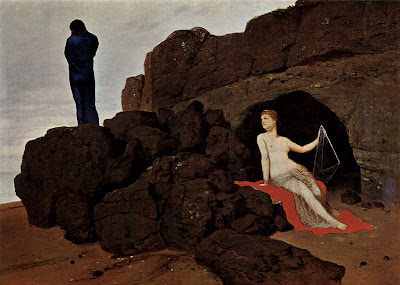
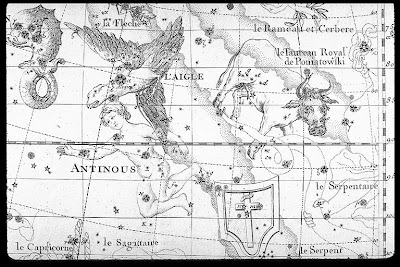







Komentarų nėra:
Rašyti komentarą